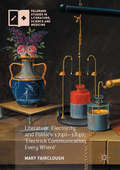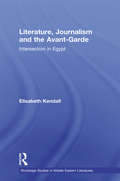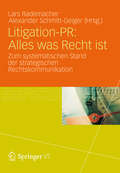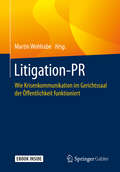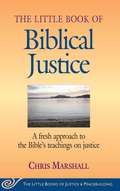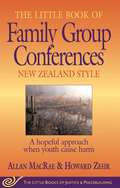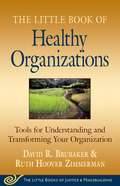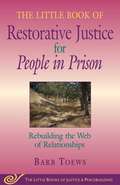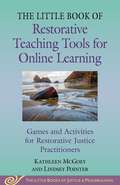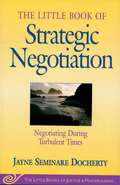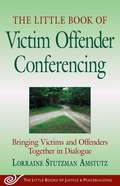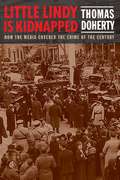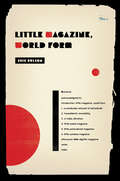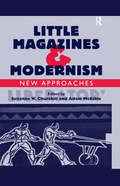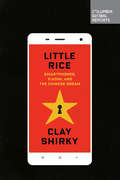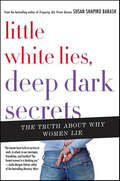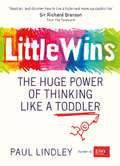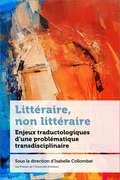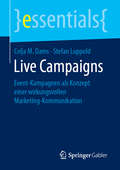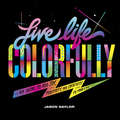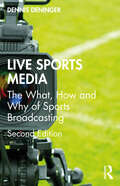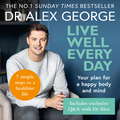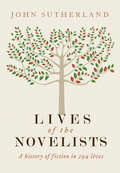- Table View
- List View
Literature, Electricity and Politics 1740–1840
by Mary FaircloughThis book investigates the science of electricity in the long eighteenth century and its textual life in literary and political writings. Electricity was celebrated as a symbol of enlightened progress, but its operation and its utility were unsettlingly obscure. As a result, debates about the nature of electricity dovetailed with discussions of the relation between body and soul, the nature of sexual attraction, the properties of revolutionary communication and the mysteries of vitality. This study explores the complex textual manifestations of electricity between 1740 and 1840, in which commentators describe it both as a material force and as a purely figurative one. The book analyses attempts by both elite and popular practitioners of electricity to elucidate the mysteries of electricity, and traces the figurative uses of electrical language in the works of writers including Mary Robinson, Edmund Burke, Erasmus Darwin, John Thelwall, Mary Shelley and Richard Carlile.
Literature, Journalism and the Avant-Garde: Intersection in Egypt (Routledge Studies in Middle Eastern Literatures)
by Elisabeth KendallThe author explores the role of journalism in Egypt in effecting and promoting the development of modern Arabic literature from its inception in the mid-nineteenth century to the present day. Remapping the literary scene in Egypt over recent decades, Kendall focuses on the independent, frequently dissident, journals that were the real hotbed of innovative literary activity and which made a lasting impact by propelling Arabic literature into the post-modern era.
Litigation-PR: Alles was Recht ist
by Alexander Schmitt-Geiger Andreas Köhler Lars Rademacher Alice SchwarzerDieses Buch fasst die aktuelle Diskussion um die Bedeutung und Funktion der strategischen Rechtskommunikation zusammen. Ausgehend vom amerikanischen Vorbild hat sich die Kommunikationsberatung in und um Gerichtsverfahren in Deutschland und Europa sprunghaft ausgebreitet. Im vorliegenden Band kommen wichtige Vertreter der theoretischen Fundierung und Weiterentwicklung des Feldes ebenso zur Sprache wie die führenden Vertreter der Praxis auf Seiten des Journalismus, der Staatsanwaltschaften bzw. Gerichte und der Beratung.
Litigation-PR: Wie Krisenkommunikation im Gerichtssaal der Öffentlichkeit funktioniert
by Martin WohlrabeEin Unternehmen, das in einen Rechtsstreit verwickelt ist, muss heute nicht mehr nur die Richter überzeugen – sondern auch die Öffentlichkeit. Denn was nützt eine gewonnene juristische Auseinandersetzung, wenn dabei die Reputation verloren geht? Dieses Buch will Anwälte, Sprecher und Manager auf den Tag X vorbereiten: auf den Moment, wenn der Ruf von Klienten auf dem Spiel steht. Die Autoren berichten, wie sie PR-Krisen erlebt und gelöst haben. Sie erklären, wie Medien funktionieren. Und sie geben Tipps, wie man im Gerichtssaal der Öffentlichkeit besteht. Die praxisnahen Beiträge und Interviews befassen sich unter anderem damit,welche Strategien bei Litigation-PR und Krisen-PR erfolgversprechend sind,was strategische Rechtskommunikation in verschiedenen Rechtsgebieten leisten kann,welche Erfahrungen Betroffene im Umgang mit medialen Krisen gemacht haben,wie Journalisten bei Rechtsstreitigkeiten recherchieren und berichten sowiewelche juristischen Aspekte in der Kommunikation zu berücksichtigen sind.Der HerausgeberRA Martin Wohlrabe war viele Jahre als Journalist für die Wirtschaftsredaktion der BILD-Zeitung tätig. Außerdem schrieb er für SPIEGEL Online und sammelte Erfahrung in der SPIEGEL-Gerichtsreportage. Darüber hinaus arbeitete Wohlrabe als Referent von Wolfgang Schäuble im Deutschen Bundestag und verantwortete dort die Pressearbeit des Ministers mit. Wohlrabe ist Gesellschafter der Litigation- und Krisen-PR-Agentur CONSILIUM, die unter anderem den jährlichen Rechtskommunikationsgipfel ausrichtet, und Lehrbeauftragter für Strategische Rechtskommunikation an der Universität Freiburg.Die Beitragsautoren und InterviewpartnerDr. Thomas Middelhoff (Autor)Gernot Lehr (Redeker Sellner Dahs)Martin U. Müller (Der Spiegel)Jens-Oliver Voß (Deutsche Bahn)Andrea Titz (Amtsgericht Wolfratshausen)Prof. Dr. Christoph Knauer (Ufer Knauer Rechtsanwälte)Pia Lorenz (Legal Tribune Online)Dr. Sebastian Rudolph (Porsche)Joachim Wolbergs (langjähriger Oberbürgermeister Regensburg)Tobias Vogl (FDP-Fraktion im Bayerischen Landtag)Prof. Dr. Matthias Jahn (Goethe-Universität Frankfurt)Dr. Fabian Meinecke (Olfen Meinecke Völger)Prof. Dr. Hans Mathias Kepplinger, Pablo Jost (Johannes Gutenberg-Universität Mainz)Karin Matussek (Bloomberg News)Prof. Dr. Patrick L. Krauskopf, Seraina Gut (ZHAW Winterthur)Thomas Seeger (Alfred Ritter GmbH & Co. KG)Martin Wohlrabe, Lou Siebert, Franziska Seusing, Arianna Elsässer, Ann-Katrin Adriaans, Albert Neukirch (CONSILIUM Rechtskommunikation GmbH)
Little Book of Biblical Justice: A Fresh Approach To The Bible's Teachings On Justice
by Chris Marshall"The purpose of this Little Book is to identify some characteristic features of the Bible's teaching on justice. "The Bible has had a profound impact on the development of Western culture. So exploring biblical perspectives on justice can help us appreciate some of the convictions and values that have helped shape Western political and judicial thought. "Christians also regard the Bible as a uniquely important source of guidance on matters of belief and practice. What the Bible has to say about justice, therefore -- both social justice and criminal justice -- ought to be of great significance for Christian thought and action today. "Yet coming to grips with biblical teaching on justice is by no means easy." Upfront, Marshall addresses the many complexities that surround "justice" in the Bible: the Bible seems to hold conflicting points of view; there is a huge amount of data to deal with; the world of the Bible and our present world are vastly different. Marshall's honest treatment of this subject is direct, yet almost lyrical in tone. He manages a thorny, multi-faceted subject clearly and ultimately singles out the broad areas of theological agreement among the Bible's writers. Highly stimulating. Highly inspirational.
Little Book of Family Group Conferences New Zealand Style: A Hopeful Approach When Youth Cause Harm
by Allan MacRaeFamily Group Conferences (FGCs) are the primary forum in New Zealand for dealing with juvenile crime as well as child welfare issues. This third volume in The Little Books of Justice and Peacebuilding Series is about the juvenile justice system that is built around these conferences. Since their introduction in New Zealand, Family Group Conferences have been adopted and adapted in many places throughout the world. They have been applied in many arenas including child welfare, school discipline, and criminal justice, both juvenile and adult. In fact, FGCs have emerged as one of the most promising models of restorative justice. This Little Book describes the basics and rationale for this approach to juvenile justice, as well as how an FGC is conducted. A title in The Little Books of Justice and Peacebuilding Series.
Little Book of Healthy Organizations: Tools For Understanding And Transforming Your Organization (Little Books Of Justice And Peacebuilding Ser.)
by David BrubakerThe best way to change the world may be one organization at a time. With this ambitious claim, the authors of this highly readable primer provide insightful analysis for evaluating and improving the health of any organization. They advocate a "systems approach," which views organizations as living systems, interconnected in their various departments, and interfacing with their environments. Leaders of organizations from all sectors will find sound advice concerning the four major components of organizations -- their structure, leadership, culture, and environment. Find out: What the classic dispute over "who gets the corner office" is really about. The difference between a good leader and a great one. What new hires may know about an organization that longer-term employees don't. How organizational change and conflict are not only inevitable, but survivable. Each chapter contains examples from the authors' varied experiences with organizational change and conflict, written from a spirited, hopeful approach for creating a better world. A title in The Little Books of Justice and Peacebuilding Series.
Little Book of Restorative Justice for People in Prison: Rebuilding The Web Of Relationships (The\little Books Of Justice And Peacebuilding)
by Barb ToewsRestorative justice, with its emphasis on identifying the justice needs of everyone involved in a crime, is helping restore prisoners' sense of humanity while holding them accountable for their actions. Toews, with years of experience in prison work, shows how these practices can change prison culture and society. Written for an incarcerated audience, and for all those who work with people in prison, this book also clearly outlines the experiences and needs of this under-represented part of our society. A title in The Little Books of Justice and Peacebuilding Series.
Little Book of Restorative Teaching Tools for Online Learning: Games and Activities for Restorative Justice Practitioners (Justice and Peacebuilding)
by Lindsey Pointer Kathleen McGoeyCreating Restorative Learning Experiences Online Teaching, training, and gathering online has become a global norm since 2020. Restorative practitioners have risen to the challenge to shift restorative justice processes, trainings, and classes to virtual platforms, a change that many worried would dilute the restorative experience. How can people build relationships with genuine empathy and trust when they are not in a shared physical space? How can an online platform become an environment for people to take risks and practice new skills without the interpersonal support available when meeting face to face? This book provides instructions for experiential games and activities that are intentionally designed for online learning spaces. It builds upon the core concepts of restorative pedagogy introduced in The Little Book of Restorative Teaching Tools (2020) to guide trainers and facilitators to overcome perceived limitations of virtual training and lean into the tools and possibilities that are unique to online spaces to create meaningful, engaging restorative learning environments. This guide is a valuable resource for anyone seeking to build community and foster development of restorative justice knowledge and skills via online platforms. The games and activities included support building relationships, introducing the restorative justice philosophy, practicing key skills, and understanding and addressing structural and racial injustices. More resources are available at restorativeteachingtools.com.
Little Book of Strategic Negotiation: Negotiating During Turbulent Times
by Jayne DochertyMost books on negotiation assume that the negotiators are in a stable settintg. But what about those far thornier times when negotiation needs to happen while other fundamental factors are in uproarious change- deciding which parent will have custody of their child while a divorce is underway; bargaining between workers and management during the course of a merger and downsizing; or establishing a new government as a civil war winds down. From Docherty's experiences in environmental/public policy negotiations and community development work. A title in The Little Books of Justice and Peacebuilding Series.
Little Book of Victim Offender Conferencing: Bringing Victims And Offenders Together In Dialogue (Justice and Peacebuilding)
by Lorraine S. AmstutzVictim offender dialogues have been developed as a way to hold offenders accountable to the person they have harmed and to give victims a voice about how to put things right. It is a way of acknowledging the importance of the relationship, of the connection which crime creates. Granted, the relationship is a negative one, but there is a relationship. Amstutz has been a practitioner and a teacher in the field for more than 20 years.
Little Lindy Is Kidnapped: How the Media Covered the Crime of the Century
by Thomas DohertyThe biggest crime story in American history began on the night of March 1, 1932, when the twenty-month-old son of Charles and Anne Lindbergh was snatched from his crib in Hopewell, New Jersey. The news shocked a nation enthralled with the aviator, the first person to fly solo nonstop across the Atlantic. American law enforcement marshalled all its resources to return “Little Lindy” to the arms of his parents—and perhaps even more energized were the legions of journalists catering to a public whose appetite for Lindbergh news was insatiable.In Little Lindy Is Kidnapped, Thomas Doherty offers a lively and comprehensive cultural history of the media coverage of the abduction and its aftermath. Beginning with Lindbergh’s ascent to fame and proceeding through the trial and execution of the accused kidnapper, Doherty traces how newspapers, radio, and newsreels reported on what was dubbed the “crime of the century.” He casts the affair as a transformative moment for American journalism, analyzing how the case presented new challenges and opportunities for each branch of the media in the days before the rise of television. Coverage of the Lindbergh story, Doherty reveals, set the template for the way the media would treat breaking news ever after. An engrossing account of an endlessly fascinating case, Little Lindy Is Kidnapped sheds new light on an enduring quality of journalism ever since: the media’s eye on a crucial part of the story—itself.
Little Magazine, World Form (Modernist Latitudes)
by Eric Jon BulsonLittle magazines made modernism. These unconventional, noncommercial publications may have brought writers such as James Joyce, T. S. Eliot, Ezra Pound, Marianne Moore, Mina Loy, and Wallace Stevens to the world but, as Eric Bulson shows in Little Magazine, World Form, their reach and importance extended far beyond Europe and the United States. By investigating the global and transnational itineraries of the little-magazine form, Bulson uncovers a worldwide network that influenced the development of literature and criticism in Africa, the West Indies, the Pacific Rim, and South America.In addition to identifying how these circulations and exchanges worked, Bulson also addresses equally formative moments of disconnection and immobility. British and American writers who fled to Europe to escape Anglo-American provincialism, refugees from fascism, wandering surrealists, and displaced communists all contributed to the proliferation of print. Yet the little magazine was equally crucial to literary production and consumption in the postcolonial world, where it helped connect newly independent African nations. Bulson concludes with reflections on the digitization of these defunct little magazines and what it means for our ongoing desire to understand modernism's global dimensions in the past and its digital afterlife.
Little Magazines & Modernism: New Approaches (Literary Criticism And Cultural Theory Ser.)
by Adam McKibleLittle magazines made modernism happen. These pioneering enterprises were typically founded by individuals or small groups intent on publishing the experimental works or radical opinions of untried, unpopular, or underrepresented writers. Recently, little magazines have re-emerged as an important critical tool for examining the local and material conditions that shaped modernism. This volume reflects the diversity of Anglo-American modernism, with essays on avant-garde, literary, political, regional, and African American little magazines. It also presents a diversity of approaches to these magazines: discussions of material practices and relations; analyses of the relationship between little magazines and popular or elite audiences; examinations of correspondences between texts and images; feminist modifications of the traditional canon or histories; and reflections on the emerging field of periodical studies. All emphasize the primacy and materiality of little magazines. With a preface by Mark Morrisson, an afterword by Robert Scholes, and an extensive bibliography of little magazine resources, the collection serves both as an introduction to little magazines and a reconsideration of their integral role in the development of modernism.
Little Rice
by Clay ShirkyAlmost unknown to the rest of the globe, Xiaomi has become the world's third-largest mobile phone manufacturer. Its high-end phones are tailored to Chinese and emerging markets, where it outsells even Samsung. Since the 1990s China has been climbing up the ladder of quality, from doing knockoffs to designing its own high-end goods.Xiaomi - its name literally means "little rice" - is landing squarely in this shift in China's economy. But the remarkable rise of Xiaomi from startup to colossus is more than a business story, because mobile phones are special. The common desiderata of the global population, mobile phones offer the kind of freedom and connectedness that autocratic countries are terrified of. China's fortune and future clearly lie with "opening up" to the global market, requiring it to allow local entrepreneurs to experiment.Clay Shirky, one of the most influential and original thinkers on how technological innovation affects social change around the world, now turns his attention to the most populous country of them all. The case of Xiaomi exemplifies the balancing act that China has to perfect to navigate between cheap copies and innovation, between the demands of local and global markets, and between freedom and control.
Little White Lies, Deep Dark Secrets: The Truth About Why Women Lie
by Susan Shapiro BarashFrom the bestselling author of Tripping the Prom Queen comes a fascinating and provocative look at the reasons behind female deception. Little White Lies, Deep Dark Secrets reveals how society doles out mixed messages to women, fostering the lies they tell. Among the liars are:•A woman who shoplifts, and has it "down to a science"•A woman who tells her husband she is working late in order to be with her lover•A woman who lies about her children's achievements to her friends•A woman who pretends her husband is doing well when they are going broke•A woman who has covered up her husband's emotional abuse for years•A woman whose secret is her misery in being a stay-at-home mom in suburbia•A woman who lies about loving her partner, deciding it's better to stay than be alone•And many other secrets and deceptionsHonest and even outrageous, Susan Shapiro Barash is fast becoming the author who explores issues that are important to women—issues that they are loath to talk about . . . until now.
Little Wins: The Huge Power of Thinking Like a Toddler
by Paul Lindley'Read on, and rediscover how to live a fuller and more successful life' SIR RICHARD BRANSON, from the forewordThere are some 400 million people worldwide whose creativity, imagination and determination put the rest of us to shame. They are experts in their field, despite having no experience to speak of. Once, you were one of them too. They are toddlers - and they hold the key to unlocking our creative potential as adults.In Little Wins: The Huge Power of Thinking Like a Toddler, Ella's Kitchen founder Paul Lindley reveals the nine characteristics and behaviours that we can all learn from recalling our toddler selves. From attention-grabbing tactics that would humble most marketing experts to the art of thinking divergently, Lindley shows how much we've lost in getting old - and how we can get it back. Never mind growing up; it's time we grew down.
Littéraire, non littéraire: Enjeux traductologiques d’une problématique transdisciplinaire (Regards sur la traduction)
by Isabelle CollombatLittéraire, non littéraire aborde les aires de divergence et de convergence, les différences et les confluences entre le littéraire et le non littéraire dans la perspective d’une application à la traduction et à la traductologie. Cette réflexion épistémologique est alimentée non seulement par l’apport de traductologues, mais aussi par ceux de chercheuses et de chercheurs issus des domaines extérieurs ou connexes à la traductologie et dont cette dernière se nourrit – en l’occurrence, le droit, la lexicologie, la théorie littéraire (narratologie et histoire littéraire) et la philosophie.Le pari de ce collectif est double : d’une part, il cherche à illustrer de manière concrète comment peut fonctionner et évoluer la traductologie en tant qu’interdiscipline, voire polydiscipline, par le simple fait de réunir dans un seul ouvrage des contributions complémentaires qui, prises ensemble ou séparément, peuvent inspirer de nouvelles avenues aux traductologues. D’autre part, il vise à mettre en évidence l’urgente nécessité de repenser la traductologie dans une perspective décloisonnée.Préfacé par Christiane Nord, traductologue incarnant aujourd’hui l’héritage de la traductologie fonctionnaliste allemande, cet ouvrage réunit traductologues et non-traductologues autour de la traductologie et des vastes enjeux qu’elle embrasse, ceux-ci étant souvent sous-estimés ou méconnus en-dehors de la sphère traductologique.
Live Campaigns: Event-kampagnen Als Konzept Einer Wirkungsvollen Marketing-kommunikation (Essentials)
by Colja M. Dams Stefan LuppoldColja M. Dams und Stefan Luppold geben in diesem essential Anstöße, formulieren Antworten, erklären Zusammenhänge und treten den Beweis an für den Erfolg von neuen Marketing-Konzepten in der gelebten Praxis. Mithilfe von Beispielen aus der Praxis für die Praxis zeigen die Autoren: Live Campaigns verändern die Event-Topografie grundlegend und stellen die Face-to-Face-Kommunikation in den Mittelpunkt, weg von einem reinen Kommunikationskanal und hin zu dem zentralen POC (Point of Content). Dabei spielen Interaktion und Zielgruppen ebenso eine wichtige Rolle wie die Möglichkeit, ein solches Konzept ohne zeitliche Begrenzung zu fahren.
Live Life Colorfully: 99 Ways to Add Joy, Creativity, and Positivity to Your Life
by Jason NaylorLive Life Colorfully is a quirky, illustrated mix of inspiring words, tips and tricks, and challenges from award-winning artist, designer, and creative director Jason Naylor.This colorful book is based on one of his strongest messages, Live Life Colorfully, and will inspire everyone who picks it up.• Find the silver living, taste the rainbow, and colorize your life with this vibrant book.• Filled with bright, colorful illustrations• Sure to motivate anyone who needs a boostNaylor spreads joy and kindness around the globe using his signature bright colors and even brighter messages with typography, illustration, and large-scale worldwide murals.Live Life Colorfully is a succinct way to say, "Be yourself, be brave, be proud of who you are, be kind, be loving, be happy, and be colorful."• An inspiring book with a little bit of edge and a lot of confidence• Taking a moment to deliberately notice colors in the world around you can significantly enhance your moment, your day, and your life.• Perfect pick-me-up for self-help, motivation, and happiness seekers, as well as lovers of pop art and bright colors• You'll love this book if you love books like 52 Lists for Happiness: Weekly Journaling Inspiration for Positivity, Balance, and Joy by Moorea Seal, Steal Like an Artist: 10 Things Nobody Told You About Being Creative by Austin Kleon, and Start Where You Are: A Journal for Self-Exploration by Meera Lee Patel.
Live Sports Media: The What, How and Why of Sports Broadcasting
by Dennis DeningerIn Live Sports Media: The What, How and Why of Sports Broadcasting, Dennis Deninger provides an all-encompassing view of the sports television industry from his own perspective as an Emmy Award-winning producer at ESPN, at a time of seismic shifts in the industry. Technological advances and the proliferation of sports content across multiple media platforms have increased accessibility to sports events of all kinds across the world. Shifts in viewing habits and audience preferences are changing the dynamic of sports media and the sports industry as a whole. The result: more power for some sectors and diminished power for many others, to which professionals in the field need to rapidly adapt. This second edition has been substantially updated to explore the impact of COVID-19 disruptions on sports and the growth of women's sports broadcasting and evolving sports, as well as political statements made in sports: Black Lives Matter, and "taking a knee." It illustrates the origins, impact, reach, economics, production, and presentation of sports on video media – including, but not limited to, television. It takes the reader behind the scenes to describe the forces and processes that have shaped and continue to change sports content, its delivery, and how it connects with fans. Dennis Deninger draws from his experiences as an expert in the industry to expose how the choices and decisions that are now being made affect the programming, content, storytelling, production, advertising, and delivery of the sports broadcasting that we will see next season and how it will evolve in the years to come. This practical, entertaining book provides insights into sports broadcasting that sports management, media, and journalism students and learning practitioners will not find anywhere else.
Live Well Every Day: THE NO.1 SUNDAY TIMES BESTSELLER
by Dr Alex George***INCLUDES EXCLUSIVE Q&A WITH DR ALEX***WHAT CAN YOU CHANGE TODAY, AND NOT PUT OFF UNTIL TOMORROW?Dr Alex is on a mission to empower readers to make their own health choices, take positive control and feel equipped and inspired to make small changes today that energize and future-proof for life. This is a book that addresses the specific key health issues of today - anxiety, social pressure and mental health, immune system and nervous system health, metabolic health, sexual health, gut health and more... Never have people been more interested in looking after their health than now, and Live Well Every Day presents the clearest and most effective health information for taking care of your body and mind from an A&E doctor. Personal and professional anecdotes from Dr Alex are included, along with practical, actionable content and weekly challenges. Small changes. Big results.(P) Octopus Publishing Group 2021
Live Well Every Day: THE NO.1 SUNDAY TIMES BESTSELLER (Dr Alex George)
by Dr Alex GeorgeTHE NO. 1 SUNDAY TIMES BESTSELLERWhat can you change today, and not put off until tomorrow?Dr Alex is on a mission to empower us to make our own health choices, take positive control and feel equipped and inspired to make those small changes today that energise and future-proof for life. 'Health and happiness come from the cumulative effects of many small and positive daily changes to our lifestyle. It's about building sustainable and healthy habits - taking small and purposeful steps to a healthy future. By the end of the book, I hope my readers have developed their own "bespoke health toolkit" to be used across every aspect of their lives, and to make long-lasting and meaningful change.'What you do consistently has a direct impact on your day-to-day health, your immune system, your mental health, your metabolism, your bone density, your heart health, your blood pressure, your energy levels and how you fight disease generally. Your lifestyle is often your body's biggest support system and the more robust you can make that the more you can rely on it to get you through every day. Think of it like your life insurance policy. Live Well Every Day addresses the very modern health challenges of today's world - anxiety; social pressure and mental health; immune system health; how to be fit, flexible and eat well in a sedentary world; sexual health; gut health and more... Get the facts, pick your goals and take action with Dr Alex. Small changes. Big results.
Live Well Every Day: THE NO.1 SUNDAY TIMES BESTSELLER (Dr Alex George)
by Dr Alex GeorgeTHE NO. 1 SUNDAY TIMES BESTSELLERWhat can you change today, and not put off until tomorrow?Dr Alex is on a mission to empower us to make our own health choices, take positive control and feel equipped and inspired to make those small changes today that energise and future-proof for life. 'Health and happiness come from the cumulative effects of many small and positive daily changes to our lifestyle. It's about building sustainable and healthy habits - taking small and purposeful steps to a healthy future. By the end of the book, I hope my readers have developed their own "bespoke health toolkit" to be used across every aspect of their lives, and to make long-lasting and meaningful change.'What you do consistently has a direct impact on your day-to-day health, your immune system, your mental health, your metabolism, your bone density, your heart health, your blood pressure, your energy levels and how you fight disease generally. Your lifestyle is often your body's biggest support system and the more robust you can make that the more you can rely on it to get you through every day. Think of it like your life insurance policy. Live Well Every Day addresses the very modern health challenges of today's world - anxiety; social pressure and mental health; immune system health; how to be fit, flexible and eat well in a sedentary world; sexual health; gut health and more... Get the facts, pick your goals and take action with Dr Alex. Small changes. Big results.
Lives of the Novelists: A History of Fiction in 294 Lives
by John SutherlandArranged in chronological order the novelist's lives are opinionated, informative, frequently funny and often shocking. Professor Sutherland's authors come from all over the world; their writings illustrate every kind of fiction from gothic, penny dreadfuls and pornography to fantasy, romance and high literature. The book shows the changing forms of the genre, and how the aspirations of authors to divert and sometimes to educate their readers has in some respects radically changed over the centuries, and in others - such as their interest in sex and relationships - remained remarkably constant.
